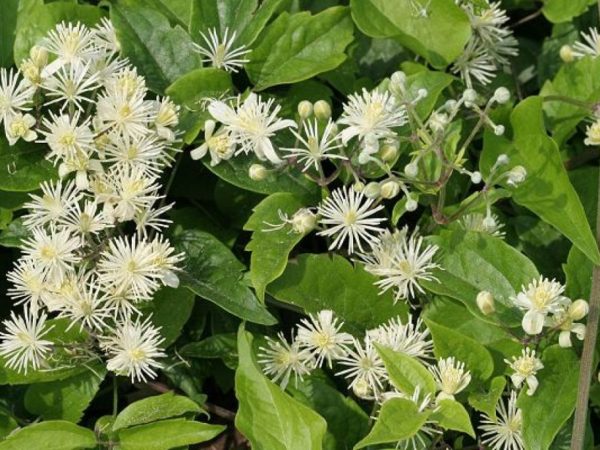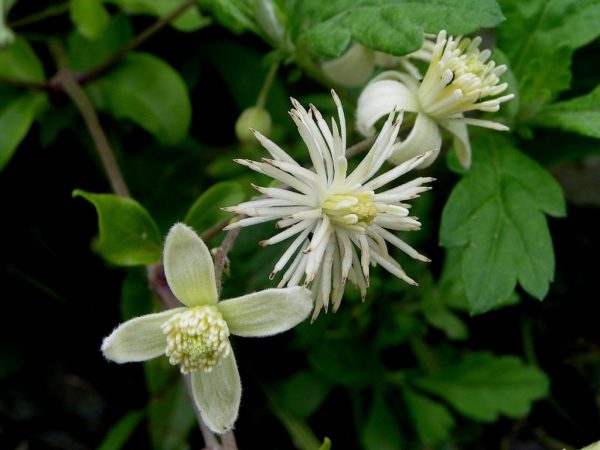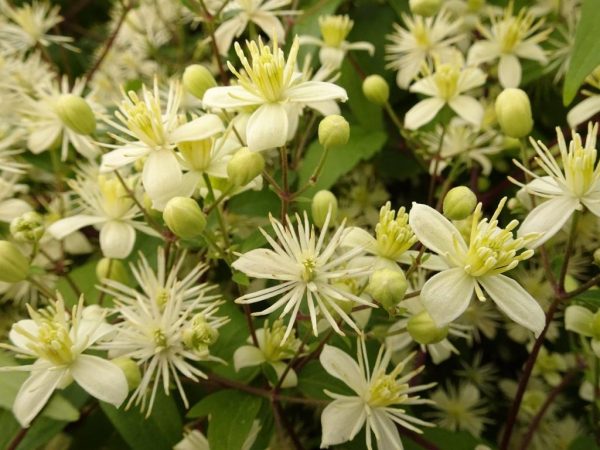Clematis Grape-leaved - plant features
Clematis Grape-leaved is a liana-like shrub with small white flowers. It was introduced into the culture at the beginning of the twentieth century and is still popular among gardeners due to its unpretentiousness. Despite the name, its leaves do not look like grape leaves, but have the same petioles, with the help of which they can trail along the support.

Clematis grape-leaved
general description
Grape-leaved Clematis is a weaving shrub from the Buttercup family. It reaches a height of 6-15 m or more, but is formed to the desired size by cutting. Stems are thin and branched, woody at the roots. Elongated leaves grow on petioles, which cling to the support during weaving.
Flowers appear on young shoots of the current year (from June to September). Flowers - small (about 2 cm in diameter), star-shaped, collected in inflorescences. Creamy white sepals (4 pieces) frame a bunch of yellowish stamens. Flowering is very abundant, with a delicate linden-like scent.
The best varieties
Vanilla - this variety is offered by the agricultural company Aelita. In essence, it is a classic vitalba clematis with slightly larger flowers (2.5 cm in diameter). The producer promises an extremely abundant flowering.
Summer snow - sometimes also referred to as a variety of grape-leaved, but in fact it belongs to the Fargese group.
- Other names: Paul Fargez or Paul Ferges, Fargesiodes, White cloud.
The difference is that it is a hybrid variety. It cannot be propagated by seeds (decorative characteristics are not preserved). The flowers are larger - 5 cm in diameter. Sepals - 5 or 6 pcs. Flowering begins in early July and lasts until September.
Landing features
Planting a vine is recommended in September, if the winter in the region is not too cold. In the north, it is better to postpone the planting time to April. In the south, it can be planted in early October.
Container-grown clematis are transplanted throughout the growing season.
The necessary conditions:
- The plant loves light, but needs midday shade (in the South it is better to plant in the shade to avoid overheating of the roots). It is necessary to consider protection from the wind: the presence of a wall, fence, trees, etc. in the neighborhood. (but the distance to structures or nearby perennials should not be less than 60 cm).
- The soils are fertile, well-drained, alkaline, without stagnant water.
For autumn planting, seedlings with developed vegetative buds are chosen, for spring planting - with 1-2 shoots. The plant should have three roots 10 cm long. Beforehand, the bush is dipped into the water by the roots and left for 2-3 hours.
Landing technology:
- A hole is dug to a depth of 60 cm and the same diameter.
- Drainage from rubble, broken brick, pebbles or shells is laid on the bottom.
- The soil is mixed with humus, peat, sand. Add 100 g of superphosphate and chalk, as well as 200 g of ash.
- The soil mixture is poured with a mound, the seedling is placed on top, and the roots are straightened down the slopes (the container plant is transferred along with the lump).
- Water the clematis with a bucket of water, cover the substrate and tamp it.
- Another watering is carried out and the soil is mulched.
- A support is installed nearby and a vine is tied up.
How to care for
Grape-leaved Clematis is completely unpretentious and needs minimal maintenance. Watering is carried out as needed, feeding - 3-4 times a season. If you want to keep the vine "within" the size, it is cut in spring and autumn.

Clematis grape-leaved photo
Watering
Clematis needs moderate watering and does not tolerate waterlogging. In hot weather, it is watered 1-2 times a week, using 2 buckets per bush. In this case, you need to ensure that water does not get on the leaves and stems.
Loosening, weeding and mulching
The soil around the bush is loosened after watering, at the same time breaking through the weeds. To facilitate care and protect the roots from overheating, mulching is used (with peat, sawdust or pine bark). The mulch is laid out in a diameter of 40-60 cm in a layer of 7-10 cm.
Top dressing
In the first year after planting, the plant does not need to be fed. Then they adhere to the power scheme:
- in early spring, watering is carried out with a lime solution (200 g of lime per 10 liters of water);
- before flowering, universal complexes of minerals are introduced;
- in the middle of summer - organic matter (infusion from compost or rotted mullein);
- in September - they make a phosphorus-potassium supplement.
In addition, it is useful to spray clematis monthly with urea and water with potassium permanganate.
Pruning
You need to prune shrubs in spring and autumn. The liana is growing rapidly, and flowers appear on the shoots of the current year: if you abandon the haircut, the flowers will appear somewhere above, and at eye level only the stems. The growth of the bush is regulated, leaving after pruning 50 cm from the ground.
Preparing for winter
An adult plant adequately tolerates winter without shelter. Young specimens are mulched with a mixture of soil and peat (8-10 cm), covered with dry foliage or spruce branches. To protect it from rodents, the bush can be covered with a wooden box.
Reproduction
Clematis grape-leaved is propagated by seeds, cuttings, shoots abduction and dividing the bush.
The first method is the most time-consuming, but it allows you to get many plants at once (reproduction often occurs by self-sowing). It is recommended to share the vine no more than once every 5 years. Cuttings and layering take root quite successfully.

Clematis grape-leaved reviews
Seeds
Seeds are stratified for three months and sown in April in a greenhouse. The temperature is maintained within the range of 20-22 ° C. When leaves appear on the seedlings, they are transplanted into separate containers. In greenhouse conditions, it grows all winter, and at the end of spring it is planted in a permanent place in the garden.
Cuttings
Cuttings are best cut in late July or early August. They are treated with root roots and deepened in a substrate of peat, earth and sand. The plantings are covered with foil to maintain temperature and humidity. Moisturize and ventilate regularly. Rooting takes place within 1-2 months.
Layers
In the spring, the selected stem is cleaned of leaves and bent to the ground, secured with wire. (The soil is pre-dug, loosened, watered). Sprinkle sand on top of the shoot and moisten it regularly. After 1-1.5 months, roots appear - the cut is cut off and transplanted.
Dividing the bush
The bush is carefully dug up and divided with a shovel into several equal parts (each must have at least one bud). Delenki are transplanted in the usual way and tied to a support. Mulch with a layer of peat and watered regularly.
Diseases and pests
| Problem | Symptoms | Prophylaxis | Treatment |
| Aphid | Colonies of bugs on the underside of the leaves. Leaves dry, curl, deform. | Correct watering. Fighting anthills. Planting calendula nearby (to attract ladybugs that eat aphids). | Remove the affected leaves, wash the vine with soapy water. In serious cases, use insecticides (Intavir, Fas, Karate). |
| Nematodes | Developmental delay, general depression, poor flowering. Brown spots on the leaves, thickening and softening of the stems, deformation of the root system. | Plant only healthy plants, carefully inspect the seedlings when purchasing. Disinfect soil and garden tools. | In the early stages of leaf and stem nematodes, the clematis and the soil should be treated with the Marshal nematicide. In the later stages, it is impossible to save the vine - it must be dug up and burned. |
| Slugs and snails | Unaesthetic holes in the leaves, which are gnawed by pests. | Sprinkle the soil with soda, tobacco, ash, and prickly stones. Water the vine at the root, and not over the leaves; in the morning, not in the evening. | Set traps, collect by hand. Use special drugs (Thunderstorm, Slime-eater). |
| Powdery mildew | White bloom, stems darken, leaves dry. | Top dressing with phosphorus and potassium, minimize nitrogen. Do not thicken the planting, cut it off in time and form a bush. Remove weeds and fallen leaves. | Cut off the affected parts, treat with potassium permanganate or Bordeaux liquid. |
| Wilt | Withering of the top, damage to clematis at the base. | Disinfection of garden tools, cleaning of fallen leaves and weeds. Soil cultivation with Trichodermin. | Cut off affected stems and burn. Treat the soil and healthy parts of the bush with Fundazol, potassium permanganate or copper sulfate. |
Testimonials
Gardeners note the unpretentiousness of grape-leaved clematis, its resistance to cold and easy care. The shrub is ideal for gardens and natural style summer cottages. It goes well with any plants, especially with a climbing rose. Long shoots can become entangled and entangled, so they need to be thinned out during formation and placed freely on a wide support.

Clematis grape-leaved vanilla
In the first season after planting, clematis grows slowly, but already in the second season, it intensively increases the green mass. Flowering becomes abundant for 2-3 years.
Judging by some reviews, liana can multiply by self-sowing and grow like a weed. Cutting it off is useless - it will only grow better. Excess plants need to be pulled out of the ground (this is not difficult, since the roots are thin and superficial).

